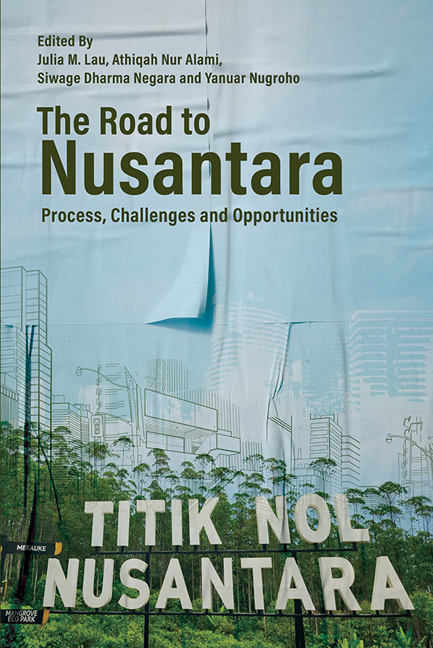Book contents
- Frontmatter
- Contents
- List of Figures
- List of Tables
- Foreword
- Foreword
- The Contributors
- Glossary
- Introduction: The Road to Nusantara—Process, Challenges and Opportunities
- PART I PROCESSES AND PATHWAYS TOWARDS NUSANTARA
- PART II CHALLENGES IN DEVELOPING NUSANTARA
- PART III OPPORTUNITIES FOR NUSANTARA
- Conclusion: Shaping Nusantara
- Index
8 - Population and Human Capital Redistribution: Understanding Opportunities and Challenges in Mass Migration to Nusantara
Published online by Cambridge University Press: 01 March 2024
- Frontmatter
- Contents
- List of Figures
- List of Tables
- Foreword
- Foreword
- The Contributors
- Glossary
- Introduction: The Road to Nusantara—Process, Challenges and Opportunities
- PART I PROCESSES AND PATHWAYS TOWARDS NUSANTARA
- PART II CHALLENGES IN DEVELOPING NUSANTARA
- PART III OPPORTUNITIES FOR NUSANTARA
- Conclusion: Shaping Nusantara
- Index
Summary
INTRODUCTION
Law No. 3 of 2022 on Indonesia's State Capital City (Ibu Kota Negara, IKN) has provided a legal framework for the development of Nusantara, the new capital city of Indonesia. The IKN's development is estimated to be accompanied by the mass in-migration of construction workers, civil servants and their family members, academics and researchers, and tertiary students. Around 1.7 to 1.9 million people are estimated to inhabit the new capital by 2045.
The residential mobility of around 250,000 construction workers and civil servants in 2024 would be the main feature of the initial phases of the capital relocation. Public service workers from particular institutions are prioritized to move earlier to Nusantara. These include the coordinating ministries, the triumvirate of the Ministries of Home Affairs, Foreign Affairs, and Defence, government agencies supporting the offices of the president and vice president and those responsible for development planning and budgeting, and law enforcement. In addition, civil servants from ministries that directly support the development of the IKN and agencies that work on basic needs services and human capital development are also targeted to migrate earlier. However, Annex II of the law states that not all public sector workers would be posted to the IKN. Several criteria have been defined as bases to assess how qualified civil servants are for the relocation, including their highest educational attainment, retirement age and performance evaluation.
In addition to being the centre of government-related activities, the IKN is designed to provide world-class tertiary education institutions focused on science, technology, engineering and mathematics (STEM), as well as specialized skills training. Although Indonesia has become one of the largest and fastest-growing tertiary education systems in the world, with approximately 7.6 million students enrolled in over 3,100 institutions, Indonesia's tertiary education system still faces problems like considerable variations in the quality of institutions. Based on the clustering of higher education institutions (HEIs) by the Ministry of Education and Culture in 2020, only fifteen Indonesian universities are acknowledged to have “excellent” academic performance and are classified in the first cluster.
- Type
- Chapter
- Information
- The Road to NusantaraProcess, Challenges and Opportunities, pp. 173 - 194Publisher: ISEAS–Yusof Ishak InstitutePrint publication year: 2023

